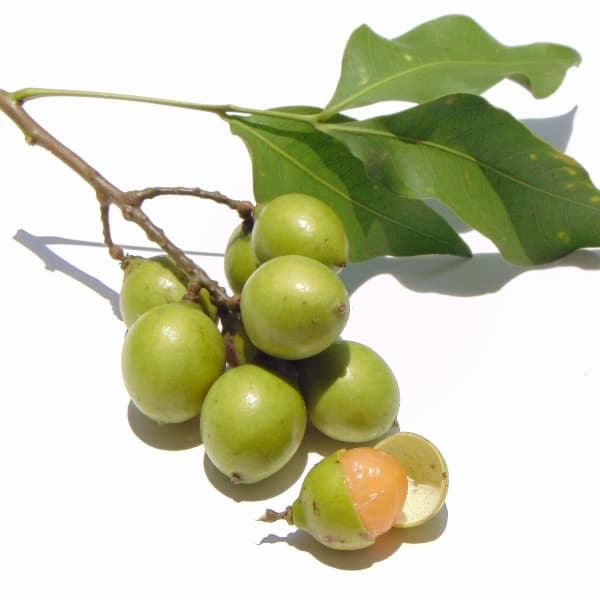Guinep, Chenet or Spanish Lime: Benefits, Uses and More
Chenette is a tiny delicious fruit that is best enjoyed cold or in Tobago. Here’s more about chenette.
If you enjoy content like this, be sure to check out these informational posts on breadfruit, pomerac, and barbadine (giant granadilla).

This post contains affiliate links.
What is guinep or chenet
Chenette is a large tropical fruit tree that bears small fruits with brittle shells. Its botanical name is Melicoccus bijugatus and is part of the soapberry family so it’s closely related to longan, lychee and rambutan.
Its common names include:
- chenette
- chennet
- guinep
- quenepa
- Spanish lime
- mamoncillo
The green shell can be easily cracked open with the teeth – it’s that brittle. The seed inside can be easily removed from there.
The pulp surrounding the seed has a light orange color, a jelly like texture and a sweet, citrusy taste. The texture is similar to rambutan.
What are the benefits of chenet
Chenette or guinep pulp contains good levels of glucose and fructose (sugars).
It also has low to moderate levels of phosphorous, calcium, iron, Vitamin C and carotene according to this 2011 US study.
The pulp is also loaded with antioxidant compounds called phenols that have tremendous health benefits.
It is loaded with phenols
This 2020 Jamaican study did a deep dive into the benefits of the fruit pulp.
It found important antioxidant compounds like epicatechin, catechin, procyanidin, together with phenols like caffeic and coumaric acid.
These phenols are known antioxidants so it is understandable why the fruit pulp is traditionally used for asthma and hypertension. The compounds also have anti-platelet activity, meaning they reduce the risk of clot formation.
It may help lower blood pressure
In an animal study from 2019, rats were fed chenette extract for 6 weeks. After that time, the animals had lower diastolic blood pressure, lower mean arterial pressure and lower heart rate.
The researchers here suggested chenette may have cardiovascular benefits. They linked these benefits to the high sugar levels and antioxidant compounds in the juice like coumaric acid.
It is antimicrobial
During this 2009 US study, chenet pulp extracts were tested on certain bacteria and yeast species. The pulp indeed showed both antibacterial and antifungal activity.
It has a long list of traditional uses
Many of the studies mentioned above also discussed the traditional uses of chenet.
The juice is commonly used to treat:
- diarrhea
- constipation
- asthma
- respiratory problems
- high blood pressure and hypertension
When is chenet season
Chenet usually bears mid-year – from late June to September. Did you know you can find the plant and the fruit to buy on Amazon? It’s true!
What can you make with chenette
Chenette or guinep is best enjoyed as it is, straight from the tree. But you can try making chenette juice or chow.
Chenette juice
To make the juice, wash the fruits, remove their outer green shells, and remove their juicy seeds. Add water to the seeds and squeeze them to extract their juice. Once that’s done, blend the liquid with sugar, ginger and your choice of sweeteners.
Check out Jamrock Vegan’s video on how to make the juice.
Chenette chow
Make this chow like any other. Peel and remove the juicy seeds and mix in chopped chadon beni, garlic, cilantro, and pepper.
Chill for at least an hour so the fresh flavors infuse into the pulp. Enjoy!
What else do you make with chenette?

most interesting. Is it related to camucamu?
delicate flavor, a pity it is not better known.
Chenette is not related to camu camu. It is a part of the soapberry family, so it is related to fruits like ackee, lychee, and rambutan.
Thank you for sharing this post, very helpful learning the nutritional value. I never tried Chenette chow. I will try it. It’s tricky to find nice size Chenette in New York, I found some but they are not the same as what I eat in Trinidad but they will do.
Enjoying some from the chaguanas area right now. Thanks. Was wonderful about the benefits.